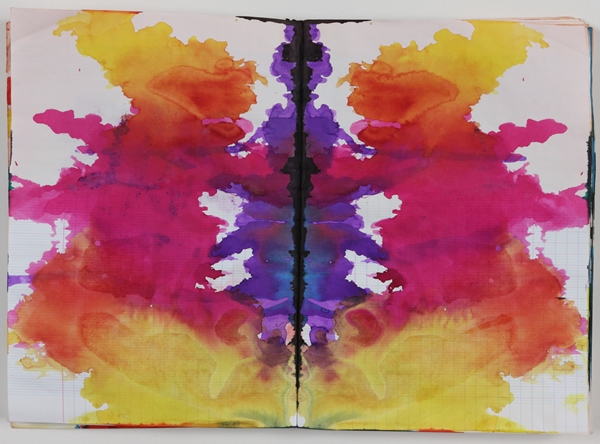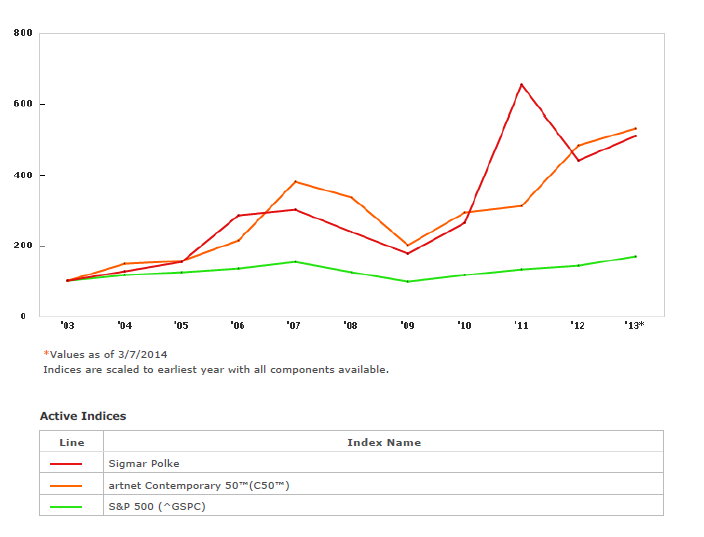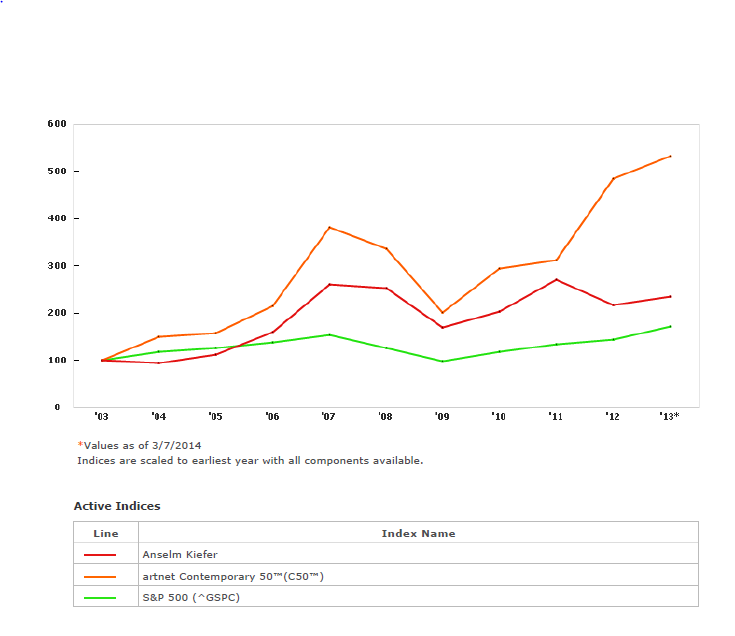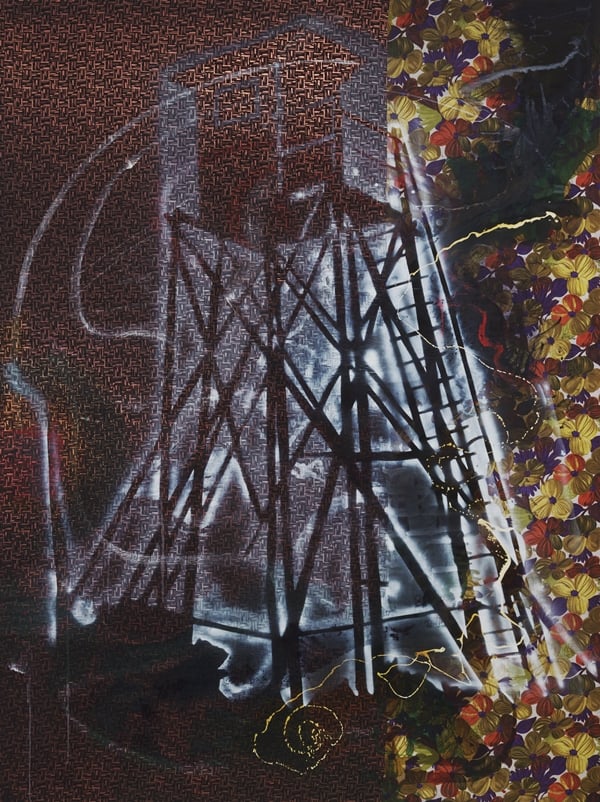Art & Exhibitions
Art Market Analysis: Sigmar Polke vs. Anselm Kiefer at Auction
On the eve of Polke's MoMA retrospective, we size up these two giants of German art.

On the eve of Polke's MoMA retrospective, we size up these two giants of German art.

In the landmark June 2011 sale at Sotheby’s London, 34 works in the collection of German industrialist Count Christian Duerckheim went up for auction, among them seven paintings by the postwar German artist Sigmar Polke (who had died the year before). Of those paintings, one, Dschungel (Jungle) (1967), brought in $9,245,139, sailing past its high estimate of $6.4 million and setting a new world record for the artist at auction. Just a month earlier, a painting by fellow German artist Anselm Kiefer, Dem unbekannten Maler (To the unknown painter) (1983), set a new record for that artist when it sold for $3.6 million at Christie’s New York.
Now, with “Alibis: Sigmar Polke 1963–2010” set to open on April 19 at the Museum of Modern Art (the exhibition is co-organized by Tate Modern), Polke’s market is doing better than ever. Though Kiefer’s market has burned bright and steady since the 1980s, Polke’s, which in comparison has seemed less vibrant, may finally be catching up, and then some.

Report Index Graph for Sigmar Polke: Over the past ten years, Polke’s market has followed the trends of the contemporary market, and outperformed it in 2006 and 2011, which indicates healthy growth of the artist’s overall market. (This graph does not include auction results for prints and multiples.)
Polke and Kiefer were born only a few years apart in 1941 and 1945, respectively. Both came of age in a nation divided—Germany in the aftermath of World War Two. And both studied at the Kunstakademie Dusseldorf under Joseph Beuys. Due to their positions as artists they were tasked with the tricky job of navigating cultural memory and conceptualizing their country’s complex history, and they handled it in very different ways.
Kiefer, a painter and sculptor, is known for dealing head-on with his country’s history. Up to the mid-80s, the imagery of National Socialism dominated his subject matter, as exemplified by some of his most celebrated works—like the paintings from 1980–1983 of the buildings designed by Nazi architects Albert Speer and Wilhelm Kreis. These are also some of his most expensive paintings at auction.
His record work, Dem unbekannten Maler (To the unknown painter), depicts the courtyard of Hitler’s Chancellery in Berlin—the site of the Führer’s bunker as well as his suicide at the end of the war—as an empty and desolate structure, with darkened, seemingly burnt-out windows. Eisen-Steig (1986) shows disinterred train tracks that suggest those requisitioned by the Third Reich for transporting Jews to Auschwitz. Using his signature technique of blending natural elements like straw, dried plants, and clay onto the canvas, Kiefer’s surface materiality serves as a visual analogy for his country’s knotty history.

Report Index Graph for Anselm Kiefer: Over the past ten years, Kiefer’s market has steadily followed the trends of the contemporary market until 2011 at which time it dipped a bit and then flattened whereas the contemporary market continued to grow.
Polke, on the other hand, had a wittier, more oblique approach. Known for shifting between a wide array of media—including painting, photography, drawing, print-making, and photocopies—as well as styles and subject matter, he was as interested in the visual imagery of advertising and pop culture as he was in the barbed wire fences and watchtowers of concentration camps. Even his forays into abstraction, as with his 1968 works Konstructivistisch (Constructivist) and Moderne Kunst (Modern Art), though at first playful works in dialogue with works by artists like Kandinsky, Klee, and Malevich, seem on further consideration to be clever nods to the Nazi penchant for employing imagery as a means for solidifying power—with, for instance, their use of what appear to be deconstructed swastikas.
As Polke’s auction record shows, his works from the late-60s were his most popular and still take the top spots at auction. This was the period when he used raster dots in his works on canvas and fabric. Dschungel (Jungle) is a romantic landscape created in this form. Strand (1966), a black-and-white photograph depicting a beach scene, is another work in this vein. This piece set the artist’s earlier record at auction when it sold for $5.3 million at Christie’s London in 2007, jumping past its $2.4 million high estimate. “There weren’t many of them to begin with, and many are in museum collections or in the kind of private collections where you have to wait for them to become estates,” Amy Cappellazzo, the international cohead of postwar and contemporary art at Christie’s, said in 2011 about his Rasterbilder and why they were so hot on the market.
His more colorful works from 1983-85, like Ohne Titel, are also known to have been among his most popular at auction and in private sales.
Though Polke’s market is strong now, and according to artnet Analytics is better than ever this year, with an average sale price of $1.2 million and a sell-through rate of 80 percent (though the year is still young), it wasn’t always this good. His average sale price at auction was only steadily in the six figures beginning in 2001 when it was $128,496.

Sigmar Polke, Modern Art (Moderne Kunst) (1968). Froehlich Collection, Stuttgart.
© 2014 Estate of Sigmar Polke/ Artists Rights Society (ARS), New York / VG Bild-Kunst, Bonn.
Kiefer’s average sale price, by comparison, has been in the six figures regularly since 1988. It should be noted that he has also had the powerful machinery of the Gagosian Gallery behind him since the late-90s. But Kiefer also had mostly paintings and, in general, less volume on the market. Polke has been at auction 2,537 times with prints and multiples (which are not accounted for in artnet Analytics) making up the largest portion of his work at auction (1,352 pieces), while works on paper account for 555 items, paintings 415 items, and photographs 194. Kiefer has been at auction just 568 times, with paintings accounting for most of those numbers (374), while works on paper, photographs, sculpture, and prints and multiples have each seen 30-85 items on the block.
Another reason for Polke’s market having never been as vigorous as Kiefer’s, at least in the US, was that unlike Kiefer, Polke hadn’t been widely shown in the US in the 80s. Kiefer and Polke were among the “West German big three” (along with Gerhard Richter), according to Robert Storr. Whereas Kiefer was already showing with Marian Goodman beginning in 1981, Mary Boone in 1982, and Anthony d’Offay Gallery in London in 1983, as well as institutions including the Museum of Modern Art, the Philadelphia Museum of Art, and the Art Institute of Chicago—all before 1990. For Polke it was a different story. “When it came to the other two,” wrote Magnus Schaefer in his catalogue essay for Alibis, referring to Polke and Richter and quoting Storr, “American audiences ‘had to make do with unevenly mixed surveys and irregular solo commercial shows.’”
To American audiences familiar with the slick Pop art renderings of Lichtenstein and Warhol, Polke’s often clumsy compositions with sausages and chocolate bars and his imperfect raster dot renderings may have seemed like second-rate knock-offs of the work of those artists. “From this perspective,” writes Schaefer, “Polke’s work from the 1960s appeared to be merely a provincial reprise of American Pop art, as it did to Lucy Lippard, who dismissed it as “black-and-white paintings derived from Roy Lichtenstein.”
Polke’s institutional US debut was at the 1985 Carnegie International and it wasn’t until 1990 that the artist’s paintings and drawings were given a comprehensive survey at the San Francisco Museum of Modern Art, which traveled to the Hirshhorn Museum and Sculpture Garden in Washington, DC, the Museum of Contemporary Art in Chicago, and the Brooklyn Museum, which signified Polke’s growing reach beyond the small circle of dealers, artists, and critics who were familiar with his work. Though he showed with dealers Anthony d’Offay in London and Holly Solomon and Marian Goodman in New York, Polke did not have gallery representation until joining Michael Werner Gallery in the 90s, which continues to represent the artist’s estate and currently has a show of Polke’s early works on paper.

Sigmar Polke, Watchtower (Hochsitz). (1984). The Museum of Modern Art, New York. Fractional and promised gift of Jo Carole and Ronald S. Lauder.
© 2014 Estate of Sigmar Polke/ Artists Rights Society (ARS), New York/VG Bild‑Kunst, Bonn.
While there is a catalogue raisonné of Polke’s editioned works by Jurgen Becker, which was published in 2000 by Hatje Cantz, there is no comprehensive catalogue raisonné of his complete works, though one devoted to his paintings, photographs, and works on paper is currently underway by his estate, which was established by his widow Augustina Baroness von Nagel, and his son and daughter, Anna and Georg Polke. Experts say, the publication of such a tome will cause the value of his work to increase dramatically. For this additional reason, as compared to his contemporaries, his work, it is believed, has been undervalued.
That all seems to be shifting. Until “Alibis,” no museum has yet staged an exhibition embracing the full range of media in which Polke worked across his fifty-year career. Polke, it seems, is finally having the US reception that has long eluded him.